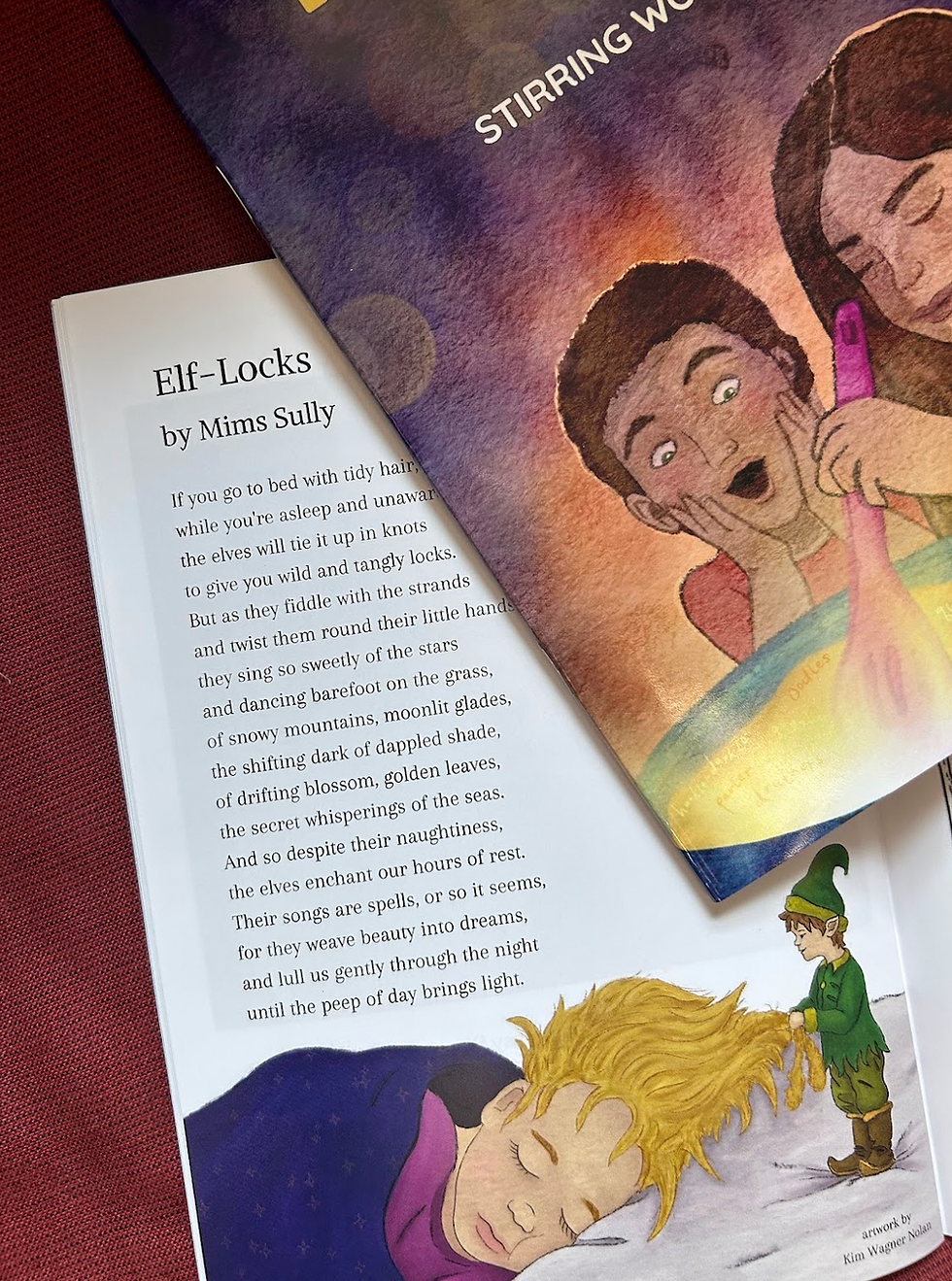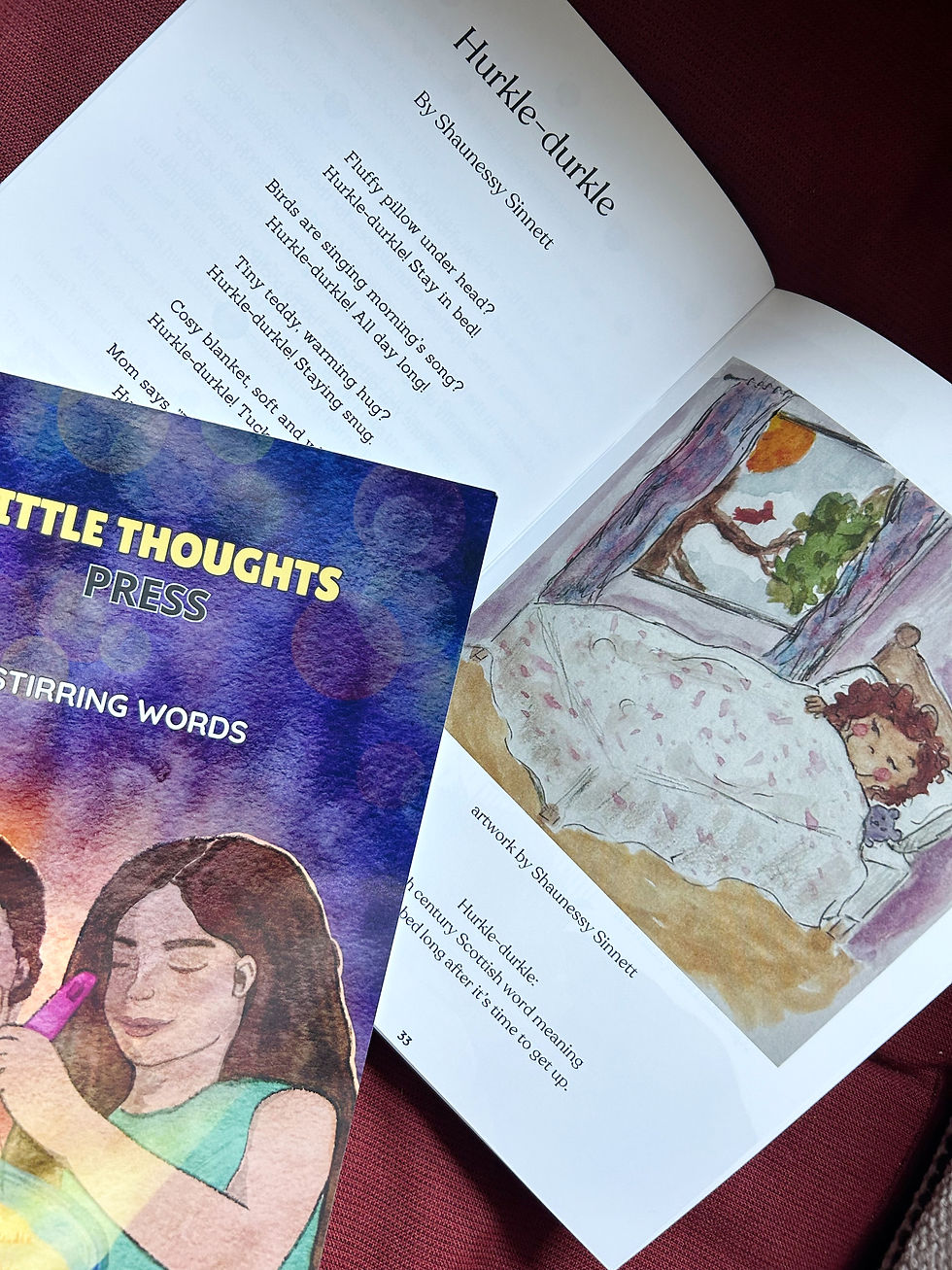Interview: Christine Hennigan
- Little Thoughts Press

- Apr 9, 2024
- 4 min read

A photograph of Little Thoughts Press Issue Six: Fantastical Fall with a sneak peek of the poem, "Potions, Five Cents," by Christine Hennigan.
Christine Hennigan loves to make people laugh, even if it gets her into trouble. She has worked with kids of all ages as a teacher and mental health counselor. When she grows up, Christine wants to be a famous chef and open a cat sanctuary. She lives in Monmouth County, New Jersey, with her husband, daughter, and kitty.
Little Thoughts Press: You have worked with kids as a teacher and a mental health counselor. In what ways have these roles informed and influenced your writing for kids? From the standpoint of both a writer and a counselor, what recommendations would you offer to kid-lit writers who want to tell stories about mental health?
Christine Hennigan: Counseling children taught me the power of characterization. When I was working with younger clients, we'd often use toys, stuffed animals, or our own invented avatars to navigate their personal stories. It can be a lot easier for children to understand themselves through relatable characters. We'd then use these alter egos as a springboard for exploring problems they are facing at home, school, or in their communities.
I applaud anyone who wants to tackle mental health in their writing. There are different ways to approach it. Personally, I like to use characters as a means of modeling healthy actions. A few examples are asking for help, being good listeners, setting boundaries, allowing oneself to feel emotions, seeking safe adults, and practicing compassionate self-talk. Writing doesn't have to be about mental health to encourage mental health. I highly encourage collaborating with a mental health professional for heavier topics, particularly ones relating to specific diagnoses or trauma, and to help with inclusive language.
Little Thoughts Press: Issue 6: Fantastical Fall is all about imagination and adventure, things that children more naturally and easily gravitate toward than adults often do. What techniques do you use to tap into your imagination and maintain a childlike sense of wonder and exploration when writing for a young audience?
Christine Hennigan: I've been writing kidlit for just about a year now, and I haven't always been in a place where I can tap into that playful side of me. I've had to do a lot of personal work on vulnerability. Decades of it, honestly. I'm a recovering perfectionist, and perfectionism and creativity aren't the best of friends. In fact, I'd say they are frenemies. On the surface, they seem to support each other, but perfectionism loves to sabotage creativity.
I'm at home full time with my 2-year-old daughter, so I'm immersed in the world of children. We take music, art, and dance classes throughout the week. These are a wonderful source of inspiration for me. I've always been a visual artist too, and recently I've been exploring the interplay of story and illustration. Collage is my primary medium, but I also paint and draw with traditional media.
Little Thoughts Press: What do you find most challenging and rewarding about writing for a young audience?
Christine Hennigan: I am such a geek, and I love learning AND teaching. So I find it tricky to strike the right balance between being an entertainer and being an educator through my writing. I use the term educator loosely (this is the School of Life I'm talking about). As much as I say I just want to write funny kids poems, I know deep down I want my readers to leave with something more than laughs.
The reward is huge though. Nothing feels better than a big grin from a child. And if a caregiver and child can laugh together, what a wonderful way to bond.
Little Thoughts Press: Which kid-lit authors and books were your favorites growing up?
Christine Hennigan: Growing up, I loved the Anastasia Krupnik series by Lois Lowry. The Baby-Sitters Club was also a favorite of mine, by Ann M. Martin. I have always been a fan of young female protagonists who are resourceful, independent, and outspoken. I was the quiet kid who had her hands folded (until I had the right answer, in which case my hand immediately shot up). I admired and lived vicariously through characters who had a bit more spunk.
Little Thoughts Press: And what about today? Any kid-lit writers you love and want to shout out?
Christine Hennigan: I recently discovered the work of Gail Carson Levine, and I wish I had read her when I was younger. I distinctly remember seeing Ella Enchanted as a new release when I was in the fifth grade, and since I was never a fan of princesses, I didn't pay much attention. Among many others, she has a poetry collection of false apologies by various famous characters, which I think is genius.
I also like Marilyn Singer, especially Have You Heard About Ladybird? Jack Prelutsky and Shel Silverstein too. Humorous poetry is my favorite.
Little Thoughts Press: What advice would you give to young writers?
Christine Hennigan: Start forming a healthy relationship with criticism early on. It's an unavoidable part of our profession, and as much as it stings, it can make you a better writer if you allow it to. There's outside criticism from the people who critique your work, and there's inside criticism from yourself. Both types can be detrimental to our art, if we give them the power.
But first and foremost, give yourself plenty of time for downtime and play. Our minds are surprisingly creative when we let them rest. This may look like riding your bike, walking your dog, napping with your cat, chopping vegetables, doodling, or taking a bath. Ideas come to us when we let ourselves slow down.




Comments